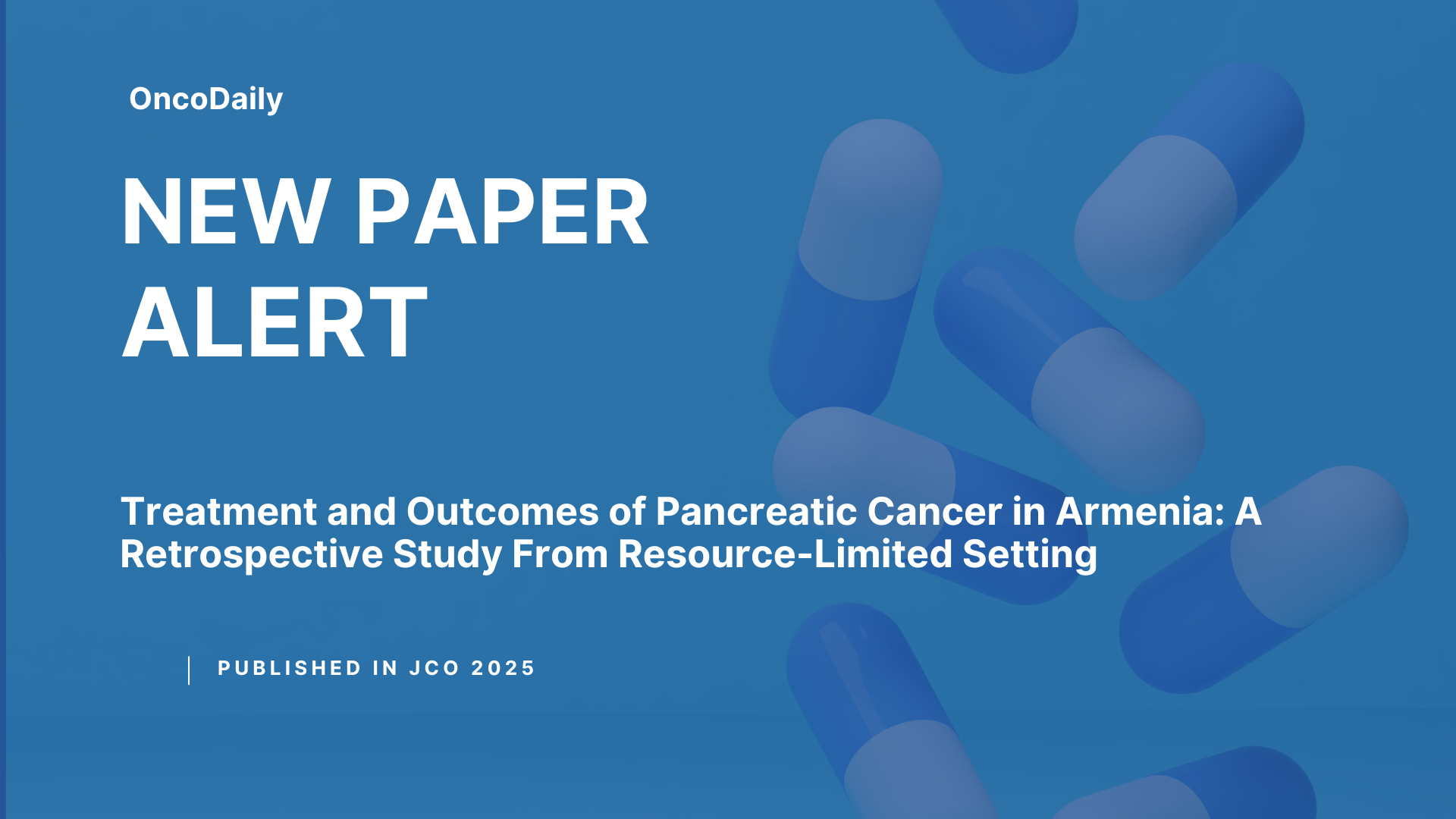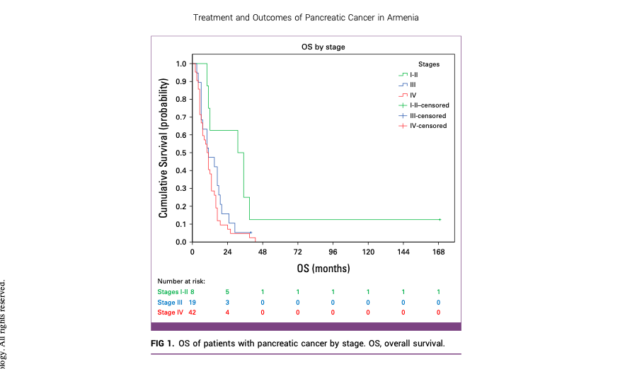Pancreatic cancer is a highly aggressive malignancy and a leading cause of cancer-related deaths worldwide. Despite advancements in diagnosis and treatment, survival rates remain low, especially in resource-limited settings like Armenia. Most patients are diagnosed at an advanced stage, limiting curative treatment options. This study examines pancreatic cancer trends, treatment approaches, and survival outcomes in Armenia, highlighting key challenges and opportunities to improve patient care.
Title: Treatment and Outcomes of Pancreatic Cancer in Armenia: A Retrospective Study From Resource-Limited Settings
Published in JCO GO, Feb 2025
Authors
Elen Baloyan, MD Davit Zohrabyan, MD, Liana Safaryan, MD, Armen Avagyan, MD, Lilit Harutyunyan, MD, Vardan Bardakhchyan, PhD , Jemma Arakelyan MD, Amalya Sargsyan MD, Martin Harutyunyan MD, Maiam Mailyan MD, Gevorg Tamamyan MD, Phd, Samvel Bardakhchyan MD
Background
Pancreatic cancer is one of the most lethal malignancies worldwide, ranking as the 12th most common cancer and the 7th leading cause of cancer-related deaths, with an annual global incidence of 495,773 cases and 466,003 deaths. The prognosis remains poor, with a 5-year survival rate of 34.3% for localized disease and only 2.7% for metastatic cases. Treatment options include surgery for resectable tumors, followed by chemotherapy, while advanced cases rely on systemic therapy. However, treatment outcomes vary by region due to healthcare disparities. This study analyzes pancreatic cancer management and survival outcomes in Armenia over a 12-year period.
Methods
A retrospective analysis was conducted using medical records from three oncology centers in Armenia—Muratsan Hospital, Mikaelyan Institute of Surgery, and Yeolyan Hematology and Oncology Center. Data were collected for patients diagnosed with pancreatic adenocarcinoma, adenosquamous carcinoma, or squamous cell carcinoma from January 1, 2010, to January 1, 2022. Patients with neuroendocrine tumors were excluded. Survival analysis was performed using Kaplan-Meier curves and the log-rank test. Overall survival (OS) was defined as the time from diagnosis to death, and statistical significance was set at P < .05.
Study Design
The study included 70 patients, representing 20%-25% of all diagnosed cases with aggressive tumor types during the study period. The median age at diagnosis was 63 years, with 58.6% of patients being over 65 years. Tumor localization was most commonly in the pancreatic head (51.4%), followed by the body (17.1%) and tail (10%). The majority (87%) had ductal adenocarcinoma. Cancer staging at diagnosis showed that 60% had stage IV disease, 27.1% had stage III, and only 11.4% had stage I-II. Liver was the most common metastatic site (81%), followed by the peritoneum (19%) and lungs (16.7%).
Panctratic Cancer Study Results
- The median OS for all patients was 11 months. Stage-specific survival analysis revealed a median OS of 31 months for stage I-II, 11 months for stage III (P = .037), and 10 months for stage IV (P = .007).
- Surgery significantly improved survival in patients with stage I-III disease (20 vs. 11 months, P = .008).
- All patients received at least one line of chemotherapy, with 37.1% undergoing second-line and only 7.1% receiving third-line therapy.
- First-line chemotherapy regimens included FOLFIRINOX (41.4%) and GemCap (38.6%), with no significant OS difference between them (13 vs. 11 months, P = .162).
- In metastatic disease, median OS for FOLFIRINOX vs. GemCap was 11 vs. 7 months (P = .285).
- Limited access to nab-paclitaxel restricted treatment options.
Key Findings
- High Disease Burden: Pancreatic cancer incidence in Armenia is 8.9 per 100,000, with a mortality rate of 8.6 per 100,000—higher than in North America (6.6 per 100,000) and Asia (3.3 per 100,000).
- Late-Stage Diagnosis: Over 60% of cases were diagnosed at stage IV, highlighting the need for improved early detection strategies.
- Surgical Impact: Patients who underwent surgery had significantly better survival (20 vs. 11 months, P = .008), emphasizing the importance of resection for localized disease.
- Chemotherapy Outcomes: No significant survival difference was observed between FOLFIRINOX and GemCap, aligning with global real-world data. Limited access to advanced therapies, such as gemcitabine plus nab-paclitaxel, restricts treatment choices in Armenia.
- Treatment Accessibility: Only 37.1% received second-line chemotherapy, compared to 65% in Europe, likely due to financial constraints and healthcare system limitations.
Key Takeaway Messages
- Earlier Diagnosis is Crucial: The high proportion of stage IV diagnoses underscores the need for early detection programs.
- Surgical Treatment Improves Survival: Efforts should focus on increasing the number of patients eligible for curative surgery.
- Chemotherapy Choices are Limited: Financial barriers and drug availability impact treatment options and survival.
- Healthcare Disparities Affect Outcomes: Survival in Armenia is lower compared to high-income countries, reflecting differences in healthcare infrastructure and treatment access.
Conclusion
Pancreatic cancer in Armenia follows global trends in incidence and mortality but presents unique challenges due to late-stage diagnosis and limited treatment access. While survival rates align with countries of similar economic status, they are significantly lower than those in well-developed healthcare systems. Expanding early detection, improving surgical interventions, and increasing access to newer chemotherapy options could enhance patient outcomes. Further research on tumor biology, predictive markers, and cost-effective treatment strategies is essential to improve survival rates in Armenia and similar resource-limited settings
Summary by Sona Karamyan, MD

